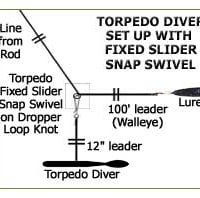I pull leadcore a lot, both in open water and following contours, but I’ve never trolled it in rivers
Everyone has their own method of fishing leadcore, but here’s some of what works for me.
First of all, I use 18 lb. leadcore. It has the maximum lead/foot of line and sinks at about 5 ft./color at 2 mph as a general rule in my experience. Lighter test leadcore has less lead/foot and heavier pound test has the same amount of lead/foot but runs shallower at the same speed because of the higher water resistance of the larger diameter sheath around the lead.
I like using a #30 linecounter reel for leadcore and a 100 yard spool of 18 lb. leadcore fits perfectly on a #30 reel without any backing. The reel spooled with leadcore is heavy, but even my wife handles them with ease and I always troll leadcore with my rods in holders anyway. I tie a barrel swivel to the business end of the leadcore and tie about 6 ft. of 15 lb. Power Pro braid onto that, terminated by a crankbait clip. I use both 8’6″ and 10′ medium action soft tipped rods and have never found the need to get expensive rods like some will claim. Cabela’s combos work perfectly well for trolling leadcore and they won’t break the bank. To check if your crankbait is still running properly, check the vibration by holding your palm on the butt of the rod handle to feel for the vibration if you can’t see it on the tip of your rod.
Leadcore trolling depth is very speed dependent. Faster than 2 mph will raise your crankbait while going too slow can cause snagging issues on the bottom. Speed is your friend while trolling contours with leadcore line. When you get shallow (and you will), give your motor gas immediately. It’ll raise your crankbait allowing them to avoid snags while allowing you to get back on course.
Prior to letting out your leadcore line, run your crankbait by the boat to check that it’s tuned properly. An improperly tuned crankbait won’t catch fish.
To fish leadcore, first mark some fish you think are walleyes and if they are in say 25 ft. (if you don’t mark them you’ll rarely catch them in 25 ft.)of water, let out 150 ft. of leadcore, set your rod in the holder and drive at 2 mph. You will probably catch walleyes. It’s that simple.
If you know there are walleyes under you but they won’t go, try triggering them with short bursts of speed, momentarily putting your motor in neutral or sharp S turns. It works more often than many would think.
Another tip……if the bite slows and you are still marking fish, change crankbaits, sometimes often. Different actions, sizes, colors, rattles or no rattles, etc. can make a big difference at times.
